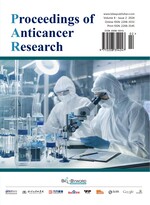Abstract
Whole grains of proso and barnyard millets were sequentially extracted using different solvents (hexane, chloroform, ethyl acetate, and methanol). Phytochemical analysis was performed qualitatively, and the total phenolic content in the extracts of proso and barnyard millets was quantified. Alkaloids and cardiac glycosides were identified in all solvent extracts of both millets. Anthraquinone and glycosides yielded negative results in all solvent extracts of both millets. Among all the solvent extracts, methanol extracts of proso and barnyard millets showed the presence of major compounds such as flavonoids, terpenoids, amino acids, tannins, and phenolics compounds. The maximum amount of phenols was found in methanolic extracts of proso and barnyard millets (0.669 ± 0.003 and 0.625 ± 0.003), followed by the chloroform extract of proso and barnyard millets (0.284 ± 0.002 and 0.257 ± 0.003). The minimum amount of phenolics was found in the acetone extract of proso and barnyard millets. The methanol extract of both millets showed the presence of major compounds with high phenolic content.
References
Harvey AL, 2007, Natural Products as a Screening Resource. Curr Opin Chem Biol, 11(5): 480–484. https://doi.org/10.1016/j.cbpa.2007.08.012
Anand P, Kunnumakara AB, Sundaram C, et al., 2008, Cancer is a Preventable Disease that Requires Major Lifestyle Changes. Pharm Res, 25(9): 2097–2116. https://doi.org/10.1007/s11095-008-9661-9
Holtekjølen AK, Kinitz C, Knutsen SH, 2006, Flavanol and Bound Phenolic Acid Contents in Different Barley Varieties. J Agric Food Chem, 54(6): 2253–2260. https://doi.org/10.1021/jf052394p
Rice-Evans C, Miller N, Paganga G, 1997, Antioxidant Properties of Phenolic Compounds. Trends Plant Sci, 2(4): 152–159. https://doi.org/10.1016/S1360-1385(97)01018-2
Yao LH, Jiang YM, Shi J, et al., 2004, Flavonoids in Food and Their Health Benefits. Plant Foods Hum Nutr, 59(3): 113–122. https://doi.org/10.1007/s11130-004-0049-7
Diplock AT, Charleux JL, Crozier-Willi G, et al., 1998, Functional Food Science and Defence Against Reactive Oxidative Species. Br J Nutr, 80 Suppl 1: S77–S112. https://doi.org/10.1079/bjn19980106
Chandrasekara A, Shahidi F, 2010, Content of Insoluble Bound Phenolics in Millets and Their Contribution to Antioxidant Capacity. J Agric Food Chem, 58(11): 6706–6714. https://doi.org/10.1021/jf100868b
Adom KK, Liu RH, 2002, Antioxidant Activity of Grains. J Agric Food Chem, 50(21): 6182–6187. https://doi.org/10.1021/jf0205099
Gani A, Wani SM, Masoodi FA, et al., 2012, Whole-Grain Cereal Bioactive Compounds and Their Health Benefits: A Review. J Food Process Technol, 3(3): 146.
Harborne JB, 1973, Phytochemical Methods. Chapman and Hall Ltd., London.
Trease GE, Evans WC, 2002, Pharmacognosy, 15th edition. Saunders Publishers, London.
Ogunyemi A, 1979, The Origin of Herbal Cure and Its Spread, in Proceedings of the Conference on African Medicinal Plants. Ile-Ife University Press, 20–22.
Singleton VL, Rossi JA, 1965, Colorimetry of Total Phenolics with Phosphomolybdic-Phosphotungstic Acid Reagents. Am J Enol Vitic, 16(3): 144–158.
Ismail A, Marjan ZM, Foong CW, 2004, Total Antioxidant Activity and Phenolic Content in Selected Vegetables. Food Chem, 87(4): 581–586. http://dx.doi.org/10.1016/j.foodchem.2004.01.010
Newman DJ, Cragg GM, 2016, Natural Products as Sources of New Drugs from 1981 to 2014. J Nat Prod, 79(3): 629–661. https://doi.org/10.1021/acs.jnatprod.5b01055
Rao BR, Nagasampige MH, Ravikiran M, 2011, Evaluation of Nutraceutical Properties of Selected Small Millets. J Pharm Bioallied Sci, 3(2): 277–279. https://doi.org/10.4103/0975-7406.80775
Suma PF, Urooj A, 2012, Antioxidant Activity of Extracts from Foxtail Millet (Setaria italica). J Food Sci Technol, 49(4): 500–504. https://doi.org/10.1007/s13197-011-0300-9
Liyana-Pathirana C, Dexter J, Shahidi F, 2006, Antioxidant Properties of Wheat as Affected by Pearling. J Agric Food Chem, 54(17): 6177–6184. https://doi.org/10.1021/jf060664d
Madhujith T, Shahidi F, 2007, Antioxidative and Antiproliferative Properties of Selected Barley (Hordeum vulgarae L.) Cultivars and Their Potential for Inhibition of Low-Density Lipoprotein (LDL) Cholesterol Oxidation. J Agric Food Chem, 55(13): 5018–5024. https://doi.org/10.1021/jf070072a
Kim J, Hyun TK, Kim M, 2010, Anti-Oxidative Activities of Sorghum, Foxtail Millet and Proso Millet Extracts. African J Biotechnol, 9(18): 2683–2690.
Ábrahám ÉB, Öri N, Szabó S, et al., 2012, Quality of Grain of Different Proso Millet (Panicum miliaceum L.) Varieties. Eur J Plant Sci Biotechnol, 6(Special Issue 2): 132–134.
Chandrasekara A, Shahidi F, 2011, Antioxidant Phenolics of Millet Control Lipid Peroxidation in Human LDL Cholesterol and Food Systems. J Am Oil Chem Soc, 89(2): 275–285. https://doi.org/10.1007/s11746-011-1918-5
Zhang L, Liu R, Niu W, 2014, Phytochemical and Antiproliferative Activity of Proso Millet. PLoS One, 9(8): e104058. https://doi.org/10.1371/journal.pone.0104058
Panwar P, Dubey A, Verma AK, 2016, Evaluation of Nutraceutical and Antinutritional Properties in Barnyard and Finger Millet Varieties Grown in Himalayan Region. J Food Sci Technol, 53(6): 2779–2787. https://doi.org/10.1007/s13197-016-2250-8
